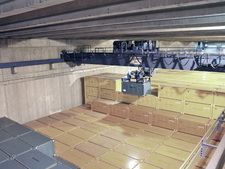Interim Storage of radioactive waste

![]() The interim storage facility in Karlsruhe
The interim storage facility in Karlsruhe
Radioactive waste having accrued and still accruing in Germany will be disposed of in Germany. Up until now there has been no operable, licensed radioactive waste repository available in Germany. Therefore, radioactive waste accruing will be stored in storage halls especially built for this purpose, so-called interim storage facilities, until they can be disposed of in a repository.
Already today, more than 106,000 cubic metres of low-level and intermediate-level radioactive waste in conditioned form – i.e. processed and packed – is stored intermediately at the surface (as in 2014):
- on the sites of the nuclear power plants,
- in three central interim storage facilities,
- in large research institutions, and
- in the eleven federal state collecting depots.
Around 300,000 cubic metres of waste with negligible heat generation until 2060
It would be possible to store altogether 400,000 cubic metres of low-level and intermediate-level radioactive waste intermediately in Germany. The data submitted by the waste producers (such as the operators of nuclear power plants) to the Federal Office for Radiation Protection enables a forecast until 2080 for the radioactive waste with negligible heat generating accruing in future. For example, ca. 300,000 cubic metres of conditioned waste are expected until the year 2060, which is to be disposed of in the Konrad repository. This includes also the waste that will accrue in the process of dismantling the nuclear power plants in Germany.
Exposure at the surface
Under radiation protection aspects, the interim storage of low-level and intermediate-level radioactive waste always represents a potential risk to the biosphere – despite technical barriers in the form of packaging and storage facilities - , as the waste emits ionising radiation. Therefore the waste needs to be monitored permanently. This is no longer necessary when the waste is disposed of in deep geological formations that are sealed from the biosphere, once the shafts have been sealed.
State of 2016.04.01

